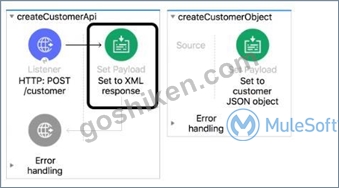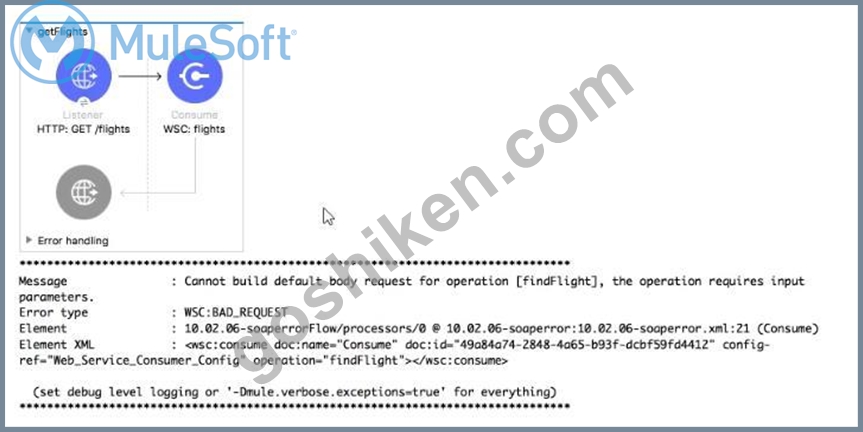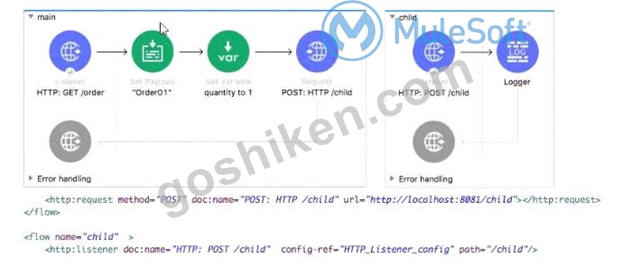MCD-Level-1学習ガイドを深く理解していただくために、当社はお客様向けに試用版を設計しました。当社の製品を購入する前に、当社の学習教材の試用版を提供します。 MCD-Level-1トレーニング資料を知りたい場合は、当社のWebページから試用版をダウンロードできます。弊社のMCD-Level-1学習教材の試用版を使用する場合、弊社の製品は試験に合格して認定を取得するのに非常に役立つことがわかります。 MCD-Level-1試験問題を購入された場合、割引を受けることをお約束します。
MuleSoft Certified Developer - Level 1(Mule 4)認定を取得することは、個人がMule 4ソリューションを開発し、実装する能力と知識を持っていることを雇用者やクライアントに示すものです。また、開発者が統合やAPI開発の成長分野でのキャリアの見通しを向上させ、新しい求人機会を開く機会を提供することもできます。
MuleSoftは、異なるアプリケーション、データソース、およびデバイスを接続するために使用される人気のある統合プラットフォームです。MuleSoft MCD-Level-1認定は、Mule 4を使用する開発者のスキルと知識を検証するために設計されています。この認定は、MuleSoftでの経験を持ち、プラットフォームの使用における自分の熟練度を証明したい開発者を対象としています。
>> MuleSoft MCD-Level-1試験解説 <<
真実的なMCD-Level-1試験解説と100%合格MCD-Level-1受験対策解説集
我々のソフトを利用してMuleSoftのMCD-Level-1試験失敗したら全額で返金するという承諾は不自信ではなく、我々のお客様への誠な態度を表わしたいです。我々はあなたに試験に安心させます。それだけでなく、あなたに我々のアフターサービスに安心させます。
Mulesoft MCD-Level-1は、MulesoftのAnyPointプラットフォームの専門家の知識と専門知識を検証することを目的とする認定試験です。 Mulesoft Certified Developer -Level 1(Mule 4)試験は、MulesoftのAnyPointプラットフォームを使用して、統合とAPIを開発、テスト、デバッグする候補者の能力を評価するように設計されています。この試験は、Mulesoftアプリケーションの開発で少なくとも1年以上の経験がある開発者を対象としています。
MuleSoft Certified Developer - Level 1 (Mule 4) 認定 MCD-Level-1 試験問題 (Q15-Q20):
質問 # 15
Refer to the exhibit.
What is the correct DataWeave expression for the Set Payload transformer to call the createCustomerObject flow with values for the first and last names of a new customer?
- A. lookupC createCustomerObJect( "Alice", "Green- ) )
- B. createCustomerObject( { first: "Alice", last: "Green" > )
- C. lookupf "createCustomerObject", { first: "Alice", last: "Green" > )
- D. createCustomerObject( "Alice", "Green")
正解:C
質問 # 16
A Mule project contains a DataWeave module like WebStore.dwl that defines a function named loginUser. The module file is located in the project's src/main/resources/libs/etl folder.
What is correct DataWeave code to import all of the WebStore.dwl file's functions and then call the loginUser function for the login "Todd.Pal@mulesoft.com"?
- A. 1. 1. import libs.etl
2. 2. ---
3. 3. WebStore.loginUser("Todd.Pal@mulesoft.com") - B. 1. 1. import * from libs::etl::WebStore
2. 2. ---
3. 3. loginUser("Todd.Pal@mulesoft.com") - C. 1. 1. import libs.etl.WebStore
2. 2. ---
3. 3. loginUser("Todd.Pal@mulesoft.com") - D. 1. 1. import * from libs::etl
2. 2. ---
3. 3. WebStore::loginUser("Todd.Pal@mulesoft.com")
正解:B
解説:
* To use custom modules, you need to import the module or functions you want to use by adding the import directive to the head of your DataWeave script, for example:
1) Does not identify any functions to import from the String module:
import dw::core::Strings
2) To identify a specific function to import from the String module:
import camelize, capitalize from dw::core::Strings
3) To import all functions from the String module:
import * from dw::core::Strings
The way you import a module impacts the way you need to call its functions from a DataWeave script. If the directive does not list specific functions to import or use * from to import all functions from a function module, you need to specify the module when you call the function from your script.
* In given scenario, it's mentioned to import all of the WebStore.dwl
So correct answer is:
質問 # 17
Which keyword do you use to create a new function in DataWeave?
- A. function
- B. map
- C. func
- D. fun
正解:D
解説:
You can define your own DataWeave functions using the fun declaration in the header of a DataWeave script. Sample is as below. ----------------------------------------
%dw 2.0
output application/json
fun toUpper(aString) = upper(aString)
---
toUpper("hello")
MuleSoft Doc Ref : https://docs.mulesoft.com/mule-runtime/4.1/dataweave-functions
質問 # 18
Refer
to the exhibits. A web client submits a request to http://localhost:8081/fliqhts?destination=SFO and the Web Service Consumer throws a WSC:BAD_REQUEST error.
What is the next step to fix this error?
- A. set a JSON payload before the Consume operation that contains the destination query parameter
- B. set a SOAP payload before the Consume operation that contains the destination query parameter
- C. set a property m the Consume operation equal to the destination query parameter
- D. Set a header In the Consume operation equal to the destination query parameter
正解:B
質問 # 19
Refer to the exhibits.
The main flow contains an HTTP Request. The HTTP Listeners and HTTP Request use default configurations.
What
values are accessible in the child flow after a web client submits a request to http://localhost:8081/order? col or
= red?
- A. payload
quantity var color query param - B. payload
- C. payload
color query param - D. payload
quantity var
正解:B
質問 # 20
......
MCD-Level-1受験対策解説集: https://www.goshiken.com/MuleSoft/MCD-Level-1-mondaishu.html
- MCD-Level-1日本語版受験参考書 🖕 MCD-Level-1参考書勉強 ✨ MCD-Level-1受験料過去問 ⌨ URL ⏩ www.topexam.jp ⏪をコピーして開き、⮆ MCD-Level-1 ⮄を検索して無料でダウンロードしてくださいMCD-Level-1資格トレーリング
- MCD-Level-1試験勉強書 🎽 MCD-Level-1日本語版トレーリング 🧄 MCD-Level-1日本語講座 🧗 ▶ MCD-Level-1 ◀を無料でダウンロード《 www.topexam.jp 》で検索するだけMCD-Level-1資料的中率
- 真実的なMCD-Level-1試験解説 - 合格スムーズMCD-Level-1受験対策解説集 |100%合格率のMCD-Level-1模擬試験問題集 ❗ ⏩ www.topexam.jp ⏪を入力して▛ MCD-Level-1 ▟を検索し、無料でダウンロードしてくださいMCD-Level-1問題例
- MCD-Level-1試験の準備方法|高品質なMCD-Level-1試験解説試験|最新のMuleSoft Certified Developer - Level 1 (Mule 4)受験対策解説集 🦰 ▷ www.topexam.jp ◁サイトにて▶ MCD-Level-1 ◀問題集を無料で使おうMCD-Level-1試験問題解説集
- 真実的なMCD-Level-1試験解説 - 合格スムーズMCD-Level-1受験対策解説集 |100%合格率のMCD-Level-1模擬試験問題集 🛳 URL 「 www.topexam.jp 」をコピーして開き、⮆ MCD-Level-1 ⮄を検索して無料でダウンロードしてくださいMCD-Level-1参考書勉強
- 試験の準備方法-効率的なMCD-Level-1試験解説試験-実用的なMCD-Level-1受験対策解説集 ⭐ 【 www.topexam.jp 】を入力して✔ MCD-Level-1 ️✔️を検索し、無料でダウンロードしてくださいMCD-Level-1日本語版受験参考書
- MCD-Level-1受験料過去問 👰 MCD-Level-1勉強ガイド 🎉 MCD-Level-1資料的中率 🤺 今すぐ⮆ www.topexam.jp ⮄で▷ MCD-Level-1 ◁を検索し、無料でダウンロードしてくださいMCD-Level-1試験対策書
- ユニーク-便利なMCD-Level-1試験解説試験-試験の準備方法MCD-Level-1受験対策解説集 🐔 Open Webサイト⏩ www.topexam.jp ⏪検索▛ MCD-Level-1 ▟無料ダウンロードMCD-Level-1問題例
- MCD-Level-1テキスト 💓 MCD-Level-1勉強ガイド 🐂 MCD-Level-1トレーニング 🐁 ⇛ www.topexam.jp ⇚で使える無料オンライン版【 MCD-Level-1 】 の試験問題MCD-Level-1勉強ガイド
- 真実的なMCD-Level-1試験解説 - 合格スムーズMCD-Level-1受験対策解説集 |100%合格率のMCD-Level-1模擬試験問題集 🥰 時間限定無料で使える( MCD-Level-1 )の試験問題は➠ www.topexam.jp 🠰サイトで検索MCD-Level-1試験参考書
- MCD-Level-1試験問題解説集 📖 MCD-Level-1勉強ガイド 🐩 MCD-Level-1資料的中率 🏖 “ www.topexam.jp ”に移動し、⏩ MCD-Level-1 ⏪を検索して無料でダウンロードしてくださいMCD-Level-1受験料過去問

